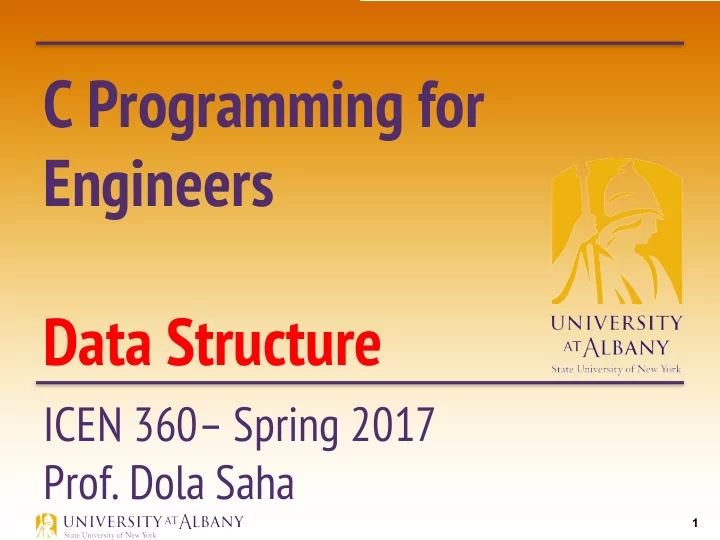

C Programming for Engineers Data Structure ICEN 360– Spring 2017 Prof. Dola Saha 1
Data Structures Ø We’ve studied fixed-size data structures such as single- subscripted arrays, double-subscripted arrays and structs. Ø This topic introduces dynamic data structures with sizes that grow and shrink at execution time. § Linked lists are collections of data items “lined up in a row”—insertions and deletions are made anywhere in a linked list. § Stacks are important in compilers and operating systems—insertions and deletions are made only at one end of a stack—its top. § Queues represent waiting lines; insertions are made only at the back (also referred to as the tail) of a queue and deletions are made only from the front (also referred to as the head) of a queue. § Binary trees facilitate high-speed searching and sorting of data, efficient elimination of duplicate data items, representing file system directories and compiling expressions into machine language. 2
Linked List Ø Linked lists are collections of data items “lined up in a row”— insertions and deletions are made anywhere in a linked list. Ø Linear Linked List Ø Doubly linked list Ø Circular linked list 3
Stacks Ø Stacks are important in compilers and operating systems— insertions and deletions are made only at one end of a stack—its top. Ø Stack is referred to as LIFO (last-in-first-out). Ø PUSH Ø POP 4
Queues Queues represent waiting lines; insertions are made only at the back Ø (also referred to as the tail) of a queue and deletions are made only from the front (also referred to as the head) of a queue. Used in networking when packets are queued to move from one layer to Ø another. Enqueue Ø Dequeue Ø 5
Trees A tree is a nonlinear, two-dimensional data structure with special Ø properties. Tree nodes contain two or more links. Ø Binary trees facilitate high-speed searching and sorting of data, efficient Ø elimination of duplicate data items, representing file system directories and compiling expressions into machine language. 6
Dynamic Memory Allocation Ø Creating and maintaining dynamic data structures requires dynamic memory allocation—the ability for a program to obtain more memory space at execution time to hold new nodes, and to release space no longer needed . Ø Functions malloc and free, and operator sizeof, are essential to dynamic memory allocation. 7
malloc() Ø void * malloc (size_t size) Ø Input: number of bytes to be allocated Ø Output: a pointer of type void * (pointer to void) to the allocated memory. Ø A void * pointer may be assigned to a variable of any pointer type. Ø Example: newPtr = malloc( sizeof(int)); Ø The allocated memory is not initialized. Ø If no memory is available, malloc returns NULL. 8
free() Ø Function free deallocates memory—i.e., the memory is returned to the system so that it can be reallocated in the future. Ø To free memory dynamically allocated by the preceding malloc call, use the statement o free(newPtr); Ø C also provides functions calloc and realloc for creating and modifying dynamic arrays . 9
Dynamic Memory Allocation 10
Classroom Assignment Ø Create a dynamic array of N elements, where the user may choose the elements to be either integer, float or double. Once the array is created, fill the array with random numbers. Finally, print out the values. 11
Self Referencing Structures Ø A self-referential structure contains a pointer member that points to a structure of the same structure type. Ø Example: o struct node { int data; struct node *nextPtr; }; defines a type, struct node . Ø A structure of type struct node has two members— integer member data and pointer member nextPtr . 12
Linked List graphical representation 13
Insert a node in order in a list 14
Insert a node – C code 15
Delete a node from list 16
Delete a node – C code 17
Classwork Assignment Ø Write a function to print the elements of a list. 18
Recommend
More recommend